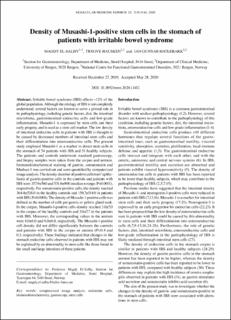| dc.contributor.author | El-Salhy, Magdy | |
| dc.contributor.author | Hausken, Trygve | |
| dc.contributor.author | Hatlebakk, Jan Gunnar | |
| dc.date.accessioned | 2021-04-26T10:47:36Z | |
| dc.date.available | 2021-04-26T10:47:36Z | |
| dc.date.created | 2020-10-06T16:16:15Z | |
| dc.date.issued | 2020 | |
| dc.Published | Molecular Medicine Reports. 2020, 22 (4), 3135-3140. | |
| dc.identifier.issn | 1791-2997 | |
| dc.identifier.uri | https://hdl.handle.net/11250/2739542 | |
| dc.description.abstract | Irritable bowel syndrome (IBS) affects ~12% of the global population. Although the etiology of IBS is not completely understood, several factors are known to serve a pivotal role in its pathophysiology, including genetic factors, diet, the intestinal microbiota, gastrointestinal endocrine cells and low‑grade inflammation. Musashi‑1 is expressed by stem cells and their early progeny, and is used as a stem cell marker. The low density of intestinal endocrine cells in patients with IBS is thought to be caused by decreased numbers of intestinal stem cells and their differentiation into enteroendocrine cells. The present study employed Musashi‑1 as a marker to detect stem cells in the stomach of 54 patients with IBS and 51 healthy subjects. The patients and controls underwent standard gastroscopy, and biopsy samples were taken from the corpus and antrum. Immunohistochemical staining of gastrin, somatostatin and Mushasi‑1 was carried out and semi‑quantified by computerized image analysis. The density (number of positive cells/mm2 epithelium) of gastrin‑positive cells in the controls and patients with IBS were 337.9±560 and 531.0±908 (median ± range; P<0.0001), respectively. For somatostatin‑positive cells, the density reached 364.4±526.0 in the healthy controls and 150.7±514.0 in patients with IBS (P<0.0001). The density of Musashi‑1‑positive cells was defined as the number of cells per gastric or pyloric gland neck. In the corpus, Musashi‑1‑positive cells density reached 3.0±7.0 in the corpus of the healthy controls and 3.8±7.7 in the patients with IBS. Moreover, the corresponding values in the antrum were 6.0±6.0 and 6.0±6.0, respectively. The Musashi‑1‑positive cell density did not differ significantly between the controls and patients with IBS in the corpus or antrum (P=0.4 and 0.3, respectively). These findings indicated that changes in the stomach endocrine cells observed in patients with IBS may not be explained by an abnormality in stem cells like those found in the small and large intestines of these patients. | en_US |
| dc.language.iso | eng | en_US |
| dc.publisher | Spandidos Publications | en_US |
| dc.rights | Attribution-NonCommercial-NoDerivatives 4.0 Internasjonal | * |
| dc.rights.uri | http://creativecommons.org/licenses/by-nc-nd/4.0/deed.no | * |
| dc.title | Density of Musashi‑1‑positive stem cells in the stomach of patients with irritable bowel syndrome | en_US |
| dc.type | Journal article | en_US |
| dc.type | Peer reviewed | en_US |
| dc.description.version | publishedVersion | en_US |
| dc.rights.holder | Copyright 2020 The Authors | en_US |
| cristin.ispublished | true | |
| cristin.fulltext | original | |
| cristin.qualitycode | 1 | |
| dc.identifier.doi | 10.3892/mmr.2020.11412 | |
| dc.identifier.cristin | 1837682 | |
| dc.source.journal | Molecular Medicine Reports | en_US |
| dc.source.40 | 22 | |
| dc.source.14 | 4 | |
| dc.source.pagenumber | 3135-3140 | en_US |
| dc.identifier.citation | Molecular Medicine Reports. 2020, 22: 3135-3140 | en_US |
| dc.source.volume | 22 | en_US |

